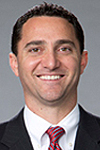Kaiser Permanente’s Department of Research and Evaluation in Southern California is 1 of 42 health systems selected to participate in a PCORI initiative.
Reducing CT Use for Adult Head Traumas

Study Finds Kaiser Permanente Intervention in Emergency Department Also Improves Identifying Injuries
Implementing a decision support tool for the use of computed tomography for adult head injuries resulted in reduced CT use and allowed for better identification of injuries, according to a new Kaiser Permanente study published recently in the Annals of Emergency Medicine.
This study examined the use of the Canadian CT Head Rule (known as CCHR) in U.S. Emergency Departments. CCHR was developed to help physicians determine which minor head injury patients needed head CT imaging. According to the study’s authors, this tool has the potential to be replicated in other health systems.

“Our aim with this study was twofold: to decrease unnecessary CT scans that may harm patients and increase costs, while ensuring patients receive the highest quality, recommended care,” said lead author and Emergency Department physician Adam L. Sharp, MD, MS, Kaiser Permanente Southern California Department of Research & Evaluation. “This effort also demonstrates the feasibility and positive impact the implementation of a clinical decision rule has on CT use in community emergency departments.”
The intervention included clinical leadership endorsement of CCHR; physician education through an e-learning module; and a clinical decision support tool embedded into the electronic health record, which prompted Emergency Department physicians to avoid CT imaging based on the CCHR recommendations.
The study included 43,053 adult trauma patients from January 2014 to December 2015 in 13 Kaiser Permanente community Emergency Departments in Southern California. Patients had a mean age of 59, were 53.6 percent female and racially diverse. Overall, 14,018 (31.1 percent) of all adult trauma patients received a head CT. Researchers noted a 5.3 percent reduction in CT use and an increase in CT-identified injuries. Nearly all (12 of 13) of the Emergency Departments reduced head CT following the implementation of the intervention.
This analysis reflects real-world examination of a simple intervention that many Emergency Departments should be able to replicate. It also adds to previous Kaiser Permanente research published earlier this year by Dr. Sharp, which found approximately 33 percent of CT scans performed for head injury could be avoided.
Additional study authors include: Brian Z. Huang, MPH, Tania Tang, PhD, MPH, Ernest Shen, PhD, and senior author Michael K. Gould, MD, MS, all with the Kaiser Permanente Department of Research & Evaluation; Michael H. Kanter, MD, regional medical director of Quality and Clinical Analysis at Kaiser Permanente in Southern California and chief quality officer, The Permanente Federation; and Edward R. Melnick, MD, MHS, and Arjun K. Venkatesh, MD, MPH, from the Department of Emergency Medicine, Yale University.
This study was supported by Kaiser Permanente Southern California’s Care Improvement Research Team internal funds, which support operational research to improve patient care.
About the Kaiser Permanente Southern California Department of Research & Evaluation
The Department of Research & Evaluation conducts high-quality, innovative research into disease etiology, prevention, treatment and care delivery. Investigators conduct epidemiologic research, health services research, biostatistics research, and behavioral research as well as clinical trials. Major areas of study include chronic disease, infectious disease, cancer, drug safety and effectiveness, and maternal and child health. Headquartered in Pasadena, California, the department focuses on translating research to practice quickly to benefit the health and lives of Kaiser Permanente Southern California members and the general public. Visit kp.org/research.
About Kaiser Permanente
Kaiser Permanente is committed to helping shape the future of health care. We are recognized as one of America’s leading health care providers and not-for-profit health plans. Founded in 1945, Kaiser Permanente has a mission to provide high-quality, affordable health care services and to improve the health of our members and the communities we serve. We currently serve more than 11.8 million members in eight states and the District of Columbia. Care for members and patients is focused on their total health and guided by their personal Permanente Medical Group physicians, specialists and team of caregivers. Our expert and caring medical teams are empowered and supported by industry-leading technology advances and tools for health promotion, disease prevention, state-of-the-art care delivery and world-class chronic disease management. Kaiser Permanente is dedicated to care innovations, clinical research, health education and the support of community health. For more information, go to: kp.org/share.

